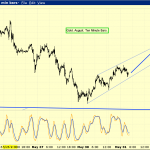If you don’t think the stock market is a giant accident waiting to happen, just consider the two most crucial developments—-soaring stocks and soaring deficits— since November 7, 2016.
First, on the lunacy side of the equation, the S&P 500 was up 35% at its 2873 peak on January 26, and now the dip-buyers, chart-readers, and robo-machines are trying mightily to retest that level after the short-lived 10% correction at the turn of the month.
But here’s the thing. The pre-Trump market at 2130 on the S&P 500 was already trading at a nosebleed 22.4X LTM earnings of $94.55 as of Q4 2016. Consistent with the pig-through-the-python profits mini-cycle of the last four years, which flows from the parallel commodity/industrial/trade cycle, LTM earnings for Q4 2017 have now come in at $106.84 per share.
Down on Wall Street, they are calling this gain a 13% Y/Y earnings rebound that justifies rising stock prices, and even buying the dip at current levels. To the contrary, we think the whole earnings growth narrative is nothing more than mullet bait; it snatches a one-year delta from the underlying trend and macro-context and thereby generates an utterly misleading conclusion.
The truth is, S&P 500 earnings are now back to where they were 39 months ago when they posted at $105.96 for the September 2014 LTM period. We’d call a $0.88 gain over more than three years a rounding error, not a sign of resurgent profits.
We’d also call the implied LTM multiple of 26.9X at the recent 2873 top just plain crazy. That’s because the current business expansion at 104 months is over and done for all practical purposes: The post-1950 average is just 61 months and the historic record is 119 months under the far more propitious circumstances of the 1990s.
In that cyclical context, the historic record leaves little doubt about the foolishness of pricing the stock market at peak PE multiples during the final innings of the business cycle.
For instance, in September 2007, the S&P 500 stood at 1530, where it was valued at 19.4X LTM earnings. At that point, the business cycle was 70 months old, and the Great Recession technically incepted 3 months later in December 2007.
The foolishness of the so-called “Goldilocks market” in the fall of 2007, therefore, is not hard to dispute: Within 18 months, recessionary earnings had collapsed by 90% and the S&P 500 had lost 55% of its pre-recession peak value.
The story at the March 2000 dot-com peak is even more telling. At that point, the longest business expansion in history was in month #109, and the S&P 500 was trading at 29.4X LTM earnings. During the next two years, of course, earnings fell by 50% and the S&P index dropped by 47%.
Moreover, there is a further dimension of the cyclical trend story that is even more crucial. Back at the peak of the dot-com cycle in 2000, the 10-year peak-to-peak earnings growth rate had been 9.5% per annum—-providing at least a modicum of justification for current stock prices.












Leave A Comment